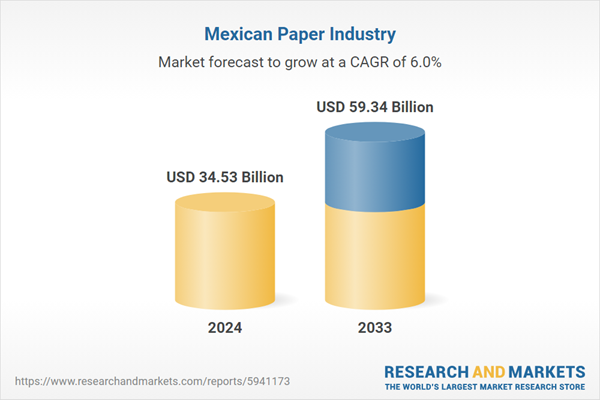Mexico's paper industry is highly concentrated, with just 27 companies producing nearly all paper products. In 2019, the industry directly employed 65,000 people in 53 manufacturing plants across 21 states. In 2023, the estimated value of paper products manufactured in Mexico will reach US$27.22 billion, representing 2.14% of Mexico's GDP. With the import value of pulp, paper and paper products expected to reach US$7.63 billion in 2023 and the export value only US$2.34 billion, this North American country has significant potential in the paper industry as domestic production cannot meet demand.
Mexico leads Latin America in the production of paper products, with three main sectors: packaging, printing/writing, and disposables. Packaging companies create a variety of solutions for industries ranging from food to electronics. Printing companies use advanced technology to produce newspapers, magazines and educational materials. Finally, the disposable paper industry provides everyday essentials such as tissues and napkins.
As mentioned, the industry is highly concentrated, with a few major brands dominating the market. Kimberly-Clark is the dominant force in disposable paper products with an estimated market share of over 60%. BIO Pappel (owner of the Scribe brand) is the largest printing and writing company, accounting for over 80% of newsprint. It is one of the largest producers of packaging paper products and has a market share of over 50% in writing paper products. Other major companies in the division include Copamex, Smurfit Kappa, Potosi, Absormex and GCP.
The current landscape of the paper industry in Mexico is shaped by a variety of factors, including economic conditions, demographic shifts, environmental priorities and technological advances. After a period of moderate expansion, the sector is now grappling with the simultaneous pressures of digital innovation and environmental awareness. While technological advancements have reduced demand for traditional paper products, the industry has shown resilience by transitioning to greener production techniques and expanding its product offerings.
Consumer preferences and sustainability concerns are driving market shifts and shaping consumer demand in significant ways. More consumers are actively seeking out companies that prioritize and integrate sustainable practices into their operations. This trend is fueling a growing demand for environmentally friendly paper products. At the same time, declining demand for traditional paper products, largely due to digitization, is being offset by a surge in packaging needs driven by the e-commerce boom. These dynamics highlight an industry in transition, adapting to meet the evolving needs of different sectors.
According to the publisher's forecast, Mexico's paper industry is expected to reflect the dynamic shift toward improved sustainability and operational efficiency. Industry advances are likely to focus on reengineering processes to reduce environmental footprints and capitalize on growing green consumerism. Meanwhile, innovation will continue to play a critical role in creating market opportunities, as manufacturers will leverage technology to develop superior and sustainable products in line with emerging consumer and industrial demand trends.
These positive developments are expected to support steady growth in the Mexican paper industry over the forecast period. According to the publisher, the market size of paper industry in Mexico is expected to reach US$ 59.34 billion in 2033, representing a compound annual growth rate (CAGR) of 6.2% from 2024 to 2033.
Topics covered:
- Mexico Paper Industry Overview
- The economic and policy environment of Mexico's paper industry
- Mexico Paper Industry Market Size, 2023-2032
- Analysis of the main Mexico paper production enterprises
- Key drivers and market opportunities for Mexico's paper industry
- What are the key drivers, challenges and opportunities for Mexico's paper industry during the forecast period 2023-2032?
- Which companies are the key players in the Mexico paper industry market and what are their competitive advantages?
- What is the expected revenue of Mexico paper industry market during the forecast period 2023-2032?
- What are the strategies adopted by the key players in the market to increase their market share in the industry?
- Which segment of the Mexico paper industry market is expected to dominate the market by 2032?
- What are the main negative factors facing the paper industry in Mexico?
Table of Contents
Companies Mentioned
- Kimberly-Clark
- Grupo Bio Pappel
- Copamex
- Smurfit Kappa
- Potosi
- Absormex CMPC Tissue
- Papeles y Conversiones de México (PCM)
- International Paper
- Essity
- Papel San Francisco
Methodology
Background research defines the range of products and industries, which proposes the key points of the research. Proper classification will help clients understand the industry and products in the report.
Secondhand material research is a necessary way to push the project into fast progress. The analyst always chooses the data source carefully. Most secondhand data they quote is sourced from an authority in a specific industry or public data source from governments, industrial associations, etc. For some new or niche fields, they also "double-check" data sources and logics before they show them to clients.
Primary research is the key to solve questions, which largely influence the research outputs. The analyst may use methods like mathematics, logical reasoning, scenario thinking, to confirm key data and make the data credible.
The data model is an important analysis method. Calculating through data models with different factors weights can guarantee the outputs objective.
The analyst optimizes the following methods and steps in executing research projects and also forms many special information gathering and processing methods.
1. Analyze the life cycle of the industry to understand the development phase and space.
2. Grasp the key indexes evaluating the market to position clients in the market and formulate development plans
3. Economic, political, social and cultural factors
4. Competitors like a mirror that reflects the overall market and also market differences.
5. Inside and outside the industry, upstream and downstream of the industry chain, show inner competitions
6. Proper estimation of the future is good guidance for strategic planning.

LOADING...
Table Information
| Report Attribute | Details |
|---|---|
| No. of Pages | 60 |
| Published | February 2024 |
| Forecast Period | 2024 - 2033 |
| Estimated Market Value ( USD | $ 34.53 Billion |
| Forecasted Market Value ( USD | $ 59.34 Billion |
| Compound Annual Growth Rate | 6.0% |
| Regions Covered | Mexico |
| No. of Companies Mentioned | 10 |









